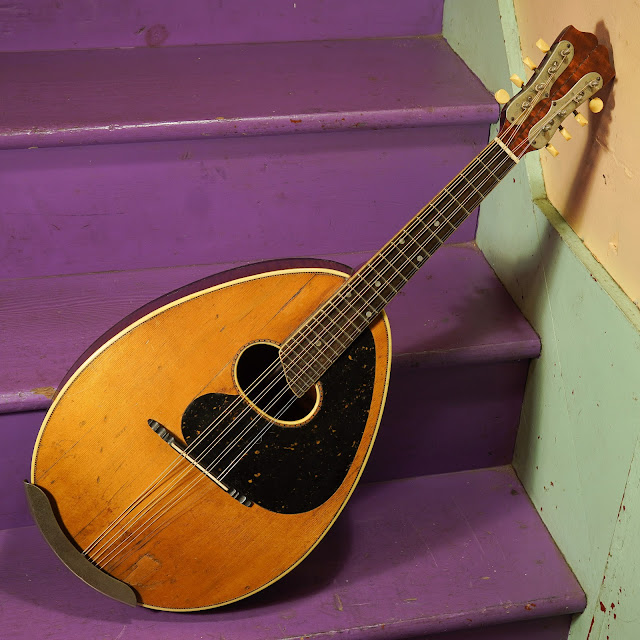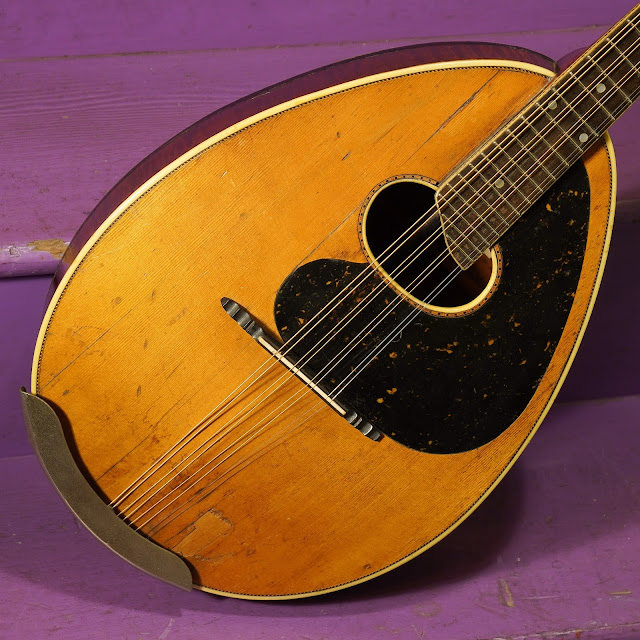1914 Weymann Style 40 Mandolute Mandola
The last time I saw this instrument was maybe around 2013. I'd fixed it up originally in 2011 (click here to see the original post on it) and then had done some emergency surgery work a couple years later just to keep it running. Since then it had been in hiding until earlier this year (May? June?) I took it back in trade in a really rough state. Since then it's been crammed in my storage space but I've been needing to get all my trade deals back into a more... liquid! ...form of currency, so I finally got around to making it a player again.
Weymann Mandolute instruments seem to have been fairly popular in their time and I've seen a few shots of whole Weymann "mandolin orchestra" ensembles from the late teens and early '20s. This mandola (vs. mandolin) is incredibly rare and I've only seen one other example (which I also worked on, check that here) since I've been fixing instruments. They're beautifully-built, interesting, and have a strange, Celtic-y, woody, sweet voice with tons of sustain when they're working well. They're not impressive volume/punch-wise in the way a Gibson or high-end Lyon & Healy (superb quality of tone in the latter) would be but they do sound very pretty behind a mic and blend with other instruments nicely.
Mandolute instruments get thicker front-to-back in the middle and thinner at the neckblock and endblock. They often have violin-looking edges on the sides (only the cheapest models didn't) and, because of the shape, the top and back are bent into a pretty extreme curve. It looks wild in person. It's not as pronounced on this mandola (which is just large in all ways), though.
Old work included a refret, fret level/dress, replacement fretboard binding, crack and seam repairs, and setup-side work. It also had all of its side/back "violin trim" missing on the bottom edge so I cleaned that area up and then painted it black to give it a "sort-of" official look. Over time, the neckblock failed (it either got bumped or just succumbed to stress), the back and sides got way more dried-out and cracked a whole bunch more and lost little bits of themselves, and I'd tried to shore it up half-way through this process with a threaded rod running through the center. This didn't really cut it but it did save the instrument from total implosion. I never got a follow-up after the last patch-up but by the time it got back to me this time around it had a few "home repair" glue-glob things done to back cracks, even more open cracks and damage to the body, and the string height had increased a bit.
This time around I shored everything up and secured it structurally with a big 1/2" dowel planted right through the endblock and epoxied and pinned both right in the heel and also the endblock. That gave me a good strong "center" to then patch-up all of the visual blem and cumbersome cracks with and, I can happily say, that it's now stable and playing beautifully and its sound has returned to the way it should be.
Repairs included: please see above -- numerous -- but this time around, I fit a structural support rod through the middle, leveled/dressed the frets, did a lot of minor fill/repair and cleats to bad cracks in the back, cleaned it up, and set it up. The tailpiece cover went missing and there's missing binding in the slightly-crunched-in endpin area, so I also retrofitted a period banjo armrest into a downmarket facsimile of an "Italian bowlback armrest" idea. Funny but it does work and looks spiffier than crunched side...
Top wood: solid spruce
Back & sides wood: solid extremely-figured maple
Bracing type: ladder
Bridge: ebonized maple with bone saddle
Fretboard: ebonized maple
Neck wood: maple 2-piece
Action height at 12th fret: 1/16" overall (fast)
String gauges: CGDA tuning, 36w, 24w, 18w, 11 (longer scale, lighter strings)
Neck shape: medium-bigger C/V
Board radius: flat
Neck relief: straight
Fret style: medium-lower
Scale length: 17"
Nut width: 1 5/16"
Body width: 12"
Body depth: 3 1/2"
Weight: 2 lbs 12 oz
Condition notes: there are cracks rudely filled, cleated, and patched all over the back, hairline side cracks that have been repaired on the bass waist area, various cleated/repaired top cracks, one top hole break replacement piece fit, missing binding under the armrest/tailpiece cover, replacement binding for the fretboard, a replacement nut, and wear and tear throughout the whole instrument. It looks mostly respectable from the front but ugly from the back and sides. Despite that, it's a proud old gal. There is a 1/2" dowel reinforcement post running through the body that's visible in the soundhole. The serial number dates to 1914 per Mr. Robinson's database and it's stamped for Style 40 at the headstock.
It comes with: no case, sorry!





























Comments